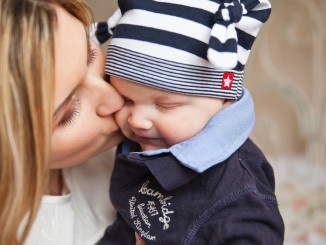
There seems to be this unspoken stigma that follows the idea of co-sleeping with your baby. Perhaps people just don’t understand why someone would want to sleep with their baby in their bed. Other people probably fear the worst after hearing stories of babies who have suffered injuries or death.
While co-sleeping is not for everyone, I do want to try and get around this stigma that surrounds the topic. I co-slept with my daughter until she was a year and a half, and it was so helpful to me. It would be a shame for parents to have the wrong idea of what co-sleeping is really like.
The Fear of Co-Sleeping
The thought of co-sleeping in the same bed with your baby can fill a parent’s heart with fear. There have been too many stories of babies who have suffocated from soft mattresses and blankets or from parents rolling over on them.
A slight fear of co-sleeping is healthy; you should always have your baby’s safety first and foremost in your mind. At the same time, the fear shouldn’t be paralyzing. Co-sleeping is completely possible for most parents as long as you take the proper precautions
As previously mentioned, co-sleeping is not for everyone. Parents who are heavy sleepers should not co-sleep with their babies. If one is a light sleeper – hopefully mom – and the other sleeps more soundly, you still need to be careful when deciding where the baby sleeps on the bed.
Safe Co-Sleeping Tips
Babies should sleep in some sort of separate bed from yours. Sleeping directly on your mattress is a suffocation hazard. You can look at in-bed co-sleepers, one that attaches to the side of the bed, or even a bedside bassinet. These should have a firm mattress and not have any blankets or pillows inside so your baby doesn’t suffocate.
You should also place your baby on the side of the parent who sleeps lighter. If dad sleeps heavily, the baby shouldn’t sleep between the parents unless they are in a very strong in-bed co-sleeper. This will reduce the risk of suffocation by a parent rolling on them.
Benefits of Co-Sleeping
For parents entertaining the thought of co-sleeping with their baby, I will tell you now that if you follow the proper safety precautions, it is completely worth it to co-sleep. There are so many benefits and it makes things much easier in the long run.
Right off the bat after you bring your baby home from the hospital, co-sleeping is a great idea for recovery. Regardless of whether you gave birth vaginally or via C-section, you will still be sore for a few days or weeks. This can make getting out of bed frequently very difficult. Needless to say, having you baby close make this easier.
One of the biggest obstacles to getting sleep with a new baby is the fact that you need to get out of bed multiple times per night to feed your baby and then taking the time to calm them back down so they can eat and fall back to sleep before you place them back in their crib.
Ironically, co-sleeping can help you get better sleep at night. You would think having your baby so close would keep you from sleeping, but instead, having them close means you don’t need to leave your bed and you can respond faster when your baby starts to stir from hunger.
It’s even better when you are breastfeeding. You don’t need to get up to make a bottle and you can simply lay your baby next to you and breastfeed while laying on your side. This is especially nice when you are recovering from a C-section delivery.
Some families don’t have a lot of space in their home, or they may live in a small apartment that doesn’t have an extra room for a nursery. Co-sleeping solves the issue of space since you don’t need much space for a bassinet or co-sleeper.
Transitioning to Crib
Another reason people may object to co-sleeping is the eventual transition to sleeping alone. While it’s true that it can be difficult to move your baby from your bed to their own, you can make the transition much easier if you are prepared and have a plan in place.
Prepare your little one’s new room to create an environment that feels safe and invites restful sleep. Decorate with colors and shapes or characters that they like.
Be sure to install blackout curtains to keep unwanted light out but keep a nightlight nearby in case your baby needs a bit of soft lighting. Keep a speaker or CD player in the room to have soft music or white noise available to help your baby sleep better.
When it’s time to make the initial move from your bed to their own, it may be a good idea to plan on spending a few nights in your child’s new room with them. It can help them feel safer in this new environment knowing you are near and that you like the room too.
Another crucial component to a smooth transition is to teach your baby to fall asleep on their own. You may be used to feeding your baby to help them sleep or giving them a pacifier, but this can actually cause more problems.
Teaching them to fall asleep without help will help all of you sleep better at night since they will be able to put themselves back to sleep when they wake up at night instead of relying on you.
Finally, consistency is key. Stick to your guns using gentle persuasion to get them to sleep alone. It may take a few days to a week, but they will eventually catch on. Once the transition is complete, everyone will be happy and sleep even better.




Be the first to comment